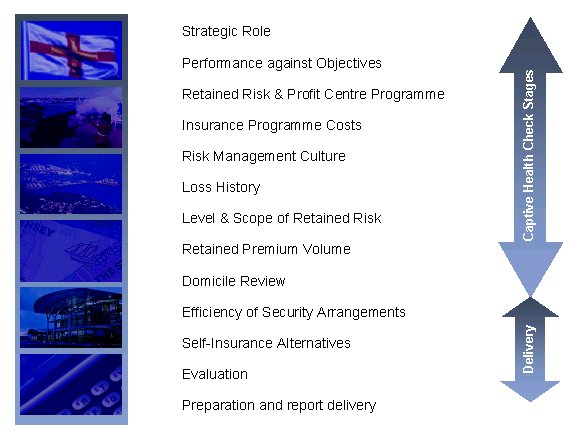Originally published in the Captive Review, Guernsey Report, October 2008
Glyn Smith of Heath Lambert tells us how to give your captive a health check to ensure its future
A CAPTIVE should be a long-term, dynamic tool used as an integral part of a comprehensive risk management strategy or in the development of an insurance profit centre.
Many captives have been established and in operation for many years, so how do their owners assess performance against strategic objectives, continue to achieve optimum risk retention levels and develop use of their captives to maximum financial benefit as they mature?
Furthermore, it is likely that as their captives have matured, owners will have seen their business interests and activities develop and evolve, much of it against a difficult political background and highly competitive and demanding market conditions. In such changing times, captives are able to evolve to respond to the many challenges which their owners face.
Heath Lambert has developed a tool – the captive health check – to help owners respond to these needs by challenging the use of such mature captives.
Designed to assess past and current performance and to focus on if and how a captive can best be used to maximum benefit going forward, it is a structured investigation which is conducted on behalf of the captive owner.
While such a review can be carried out by an existing captive manager or broker, often a second pair of eyes, without the baggage of preconceived ideas and views, can be an advantage.
Equally important is to consider whether the captive should be used for retaining more or new corporate risks which are currently either being insured in the commercial market or retained, in part, on the balance sheet; those risks for which insurance is not available at an economic rate; or where appropriate, for underwriting customer insurances.
A captive health check would normally be conducted in the following phases:
Strategic role
A review of the strategic purpose for use of the captive would be conducted first.
Strategic objectives
Key performance measures would be identified.
Review of the current insurance programme
Details which would need to be obtained and reviewed are:
Retained risk
- Risk profile
- Self insured retention levels
- Insured risks
- Limits retained
- Policy cover provided by the captive and the primary market
- Recent or planned changes in the captive parent's business
- Macro environment issues
- Micro environment issues.
Profit centre customer risk
- Size of client base
- Location and spread of client base
- Insurance products sold, existing and potential
- FSA or equivalent regulatory requirements
- Commission arrangements
- IPT position
- Delivery method
- Premium collection/banking arrangements
- Scheme administration arrangements.
Quantify current costs of the insurance programme
It would be necessary to ascertain the following costs:
- Captive premiums
- Primary market premiums
- Premiums paid by the captive for reinsurance
- Administration fees.
Determine risk management culture
It would be necessary to develop an understanding of the captive parent's ability and desire to retain risk and how they:
- Map risk exposures
- Identify and prioritise major issues
- Run in-depth analysis and programme implementation
- Monitor and control the process
- Provide authority and responsibility to ensure appropriate action is taken to minimise exposure to losses
Conduct a detailed investigation of loss history
It would be necessary to:
- Obtain detailed historical claims experience and long-tail claims triangulations
- Adjust for inflation and other quantifiable changes
- Identify any qualitative changes and their effect
- Analyse loss history to identify reasons for any adverse experience
- Model historic and projected losses.
Review the captive owner's financial position to determine the appropriate level of risk retention
A captive health check specialist would:
- Estimate a reasonable range for risk retention capacity by considering liquidity, financial strength and earnings measures from financial statements
- Estimate optimum levels of risk retention using historic and projected claims models.
Bearing in mind specific domicile regulatory requirements, there would also need to be a detailed understanding of the captive:
- Capital structure
- Margin of solvency requirements
- Risk gap issues
- Investment strategy and performance.
As a final but vital discipline in this stage, a peer group exercise would be conducted to review captive strategy against the strategy of captives owned by organisations of a similar size and/or in the same sector and to review performance by premium income, programme structure or the level of risk retained.
Research the insurance and reinsurance markets to assess suitable premium levels for the exposures retained
It would be necessary here to:
- Challenge the captive's current participation and premium volume against contemporary insurance dynamics
- Quantify the optimum level of premium to be retained for the captive's retained exposures, based on projected claims models, financial position and market premium indications
- Assess the relationship between premium volume for each class of risk, the overall exposure at both individual and aggregate levels and the spread of risk to ensure recommended premium volume would be sufficient to meet both the costs of reinsurance and retained losses.
For this part of the exercise the objective is to determine the most appropriate risk financing strategy, minimising external expenditure and dovetailing risk-bearing capacity and appetite.
Domicile review
A review as to which domicile is most suitable would be conducted. The outcome would depend on whether the programme involves retained risk or participation in customer insurances, regulatory issues, tax implications, operating costs, capital requirements and the impact of the proposed new capital regulatory regime in Europe – the Solvency II Framework Directive.
Efficiency of security arrangements
It would be necessary to:
- determine the current type and level of security required by fronting insurers
- explore viable alternatives.
Because of potential reputational risk exposure it would be important here to review any direct captive participation to address any problems which arise through the issue of a global policy, regulatory requirements over admitted and non-admitted cover and the identification, collection and payment of relevant insurance premium taxes in different territories.
'Pay as paid' clauses, trust funds, escrow accounts and performance bonds are solutions to problems with letters of credit which mitigate rather than completely remove security problems.
Security interest agreements are also excellent, widely accepted, alternative forms of security.
Investigate the possible self insurance alternatives to the formation of a captive
Other than either a captive or a protected cell company there are three basic self insurance alternatives:
- Do nothing – fund losses through the P&L account as they are paid.
- Balance sheet provisions – quantify and provide for estimated outstanding liabilities at each financial year end.
- Formal funding or virtual captive – set aside a fund at the beginning of each year for estimated retained liabilities.
The review would set out the pros and cons of these options versus the use of the captive.
Having completed the investigation, gathered all the required information and conducted a full analysis, the captive health check report would determine whether or not the captive is in good health and whether it is making a valuable contribution as part of an integrated risk management solution.
If the captive is not in good health, viable alternative risk retention options would be recommended and, where appropriate options for dealing with the past, which could involve:
- Loss portfolio transfer
- Captive run-off
- Captive sale.
Concluding, through use of a captive health check and by working closely with the captive owner's management team, captive manager and broker, an in-depth and clear understanding of group structure, business activities and risk profile is quickly gained. This enables a detailed review of performance and formulation of an innovative profit centre and/or a retained risk insurance programme. Using the model detailed means that such a programme will reflect the need to contain costs without exposing the assets, earning and liabilities of the owner to undue risk. It will also provide an opportunity to subject aspects of the owners insurance and risk management programme to a strict cost/benefit analysis; in short, to equip mature captives for a long-term future.

For more information about Guernsey's finance industry please visit www.guernseyfinance.com
The content of this article is intended to provide a general guide to the subject matter. Specialist advice should be sought about your specific circumstances.


